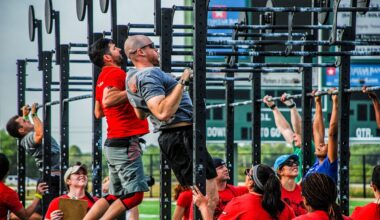How Age Impacts Muscle Strain Healing and Prevention
Understanding how age influences muscle strain healing and prevention is vital for athletes and individuals. Muscle strains occur due to overstretching or tearing of muscle fibers, which can be exacerbated by age and its associated changes. As people age, muscles naturally lose some elasticity and strength, making them more susceptible to injuries like strains. Older adults often experience slower recovery times compared to their younger counterparts. This slower healing can result from several factors that diminish regenerative capabilities, including reduced blood flow, which affects nutrient delivery to the damaged tissues. Moreover, age-related conditions, such as decreased collagen production, also affect muscle and tendon resilience. Prevention strategies become important with this understanding, focusing on proper warm-up techniques, strength training, and flexibility exercises that aim to preserve muscle function and minimize injury risks. Regular physical activity strengthens muscles and promotes flexibility and balance, which are essential to prevent strains. Engaging in age-appropriate exercise regimens tailored to individual fitness levels can help mitigate these risks and encourage a healthier, injury-free lifestyle throughout aging.
The Role of Muscle Elasticity
As one ages, muscle elasticity diminishes, significantly too. This decreased elasticity can increase vulnerability to muscle strains during physical activities. Beginning in the thirties, the natural aging process begins to impact muscle fibers and their elasticity, leading to a higher susceptibility towards injury. Strains originate from sudden stretches or excessive forces applied to these weakened muscles. Moreover, older adults may experience muscle atrophy, wherein muscle mass declines, further compounding the risk of strain. This connection highlights the importance of maintaining muscle health through regular exercise. Activities focusing on resistance training and stretching can help preserve muscle elasticity and strength. Incorporating flexibility training exercises into one’s routine is essential yet often overlooked. Practices like yoga or pilates not only improve flexibility but also enhance body awareness, promoting safer movement patterns. Hydration also plays a crucial role in muscle elasticity; therefore, older adults should ensure they drink adequate fluids. Keeping muscles well-hydrated can help maintain elasticity and overall function, reducing the likelihood of strains occurring. Small, consistent actions, such as these, help create a proactive approach in mitigating muscle strain risks as one ages.
Another factor contributing to age-related muscle strain injury is the healing process. In younger individuals, muscle tissues repair more efficiently due to a robust supply of regenerative cells and proteins. As age increases, this regenerative capacity diminishes, slowing down the healing of muscle strains. Statistical evidence supports that older individuals take longer to recover from muscle injuries due to slower cell regeneration and reduced blood circulation. This delayed healing can result in prolonged discomfort, increased fragility of the muscle tissue during recovery, and higher chances of reinjury. Therefore, age-appropriate rehabilitation strategies are crucial. It includes an emphasis on gradual recovery, focusing on controlled exercises to regain strength without overexerting the tissues. Integrating modalities like physiotherapy can be beneficial as it offers tailored healing practices to address age-specific challenges. Education about the healing stages of muscle strains is essential for older adults to manage expectations during recovery periods. Improved communication between healthcare professionals and patients regarding recovery protocols ensures that older adults are guided effectively through rehabilitation, helping them return to their activities safely and confidently.
Importance of Nutritional Support
Nutrition significantly influences muscle health and recovery in aging individuals. Adequate intake of essential nutrients is crucial in supporting muscle repair and preventing strains. Older adults may experience dietary restrictions that lead to nutrient deficiencies, negatively impacting muscle function. Protein, for instance, is vital as it aids in muscle tissue repair. Adequate protein intake can help preserve muscle mass and support healing when a strain occurs. Emphasizing high-quality protein sources, such as lean meats, dairy products, legumes, and fish is essential in any diet. Omega-3 fatty acids are also beneficial due to their anti-inflammatory properties, which can assist with muscle recovery and pain reduction. Including foods rich in antioxidants, such as fruits and vegetables, can combat oxidative stress that damages muscle tissues and slows recovery. Supplements specifically targeted for aging muscle health should also be considered; supplements containing vitamins D and B12 can play a critical role in strengthening bones and muscles. Older adults should work with healthcare professionals, such as dietitians, to define a personalized nutritional plan to support muscle strain recovery and overall health effectively.
In addition to dietary considerations, lifestyle factors significantly impact muscle strain recovery and prevention in older adults. Regular physical activity that emphasizes resistance, flexibility, and aerobic conditioning helps promote muscle health. Engaging in such activities consistently can improve muscle tone and enhance overall physical function, making individuals less prone to injuries like strains. Moreover, rest and recovery should not be underestimated; inadequate sleep can impair muscle repair processes, hindering recovery from strains. Older adults may experience disrupted sleep patterns due to various factors, including health issues. Therefore, creating a conducive sleep environment is crucial for ensuring restorative sleep. Establishing a consistent bedtime routine and practicing relaxation techniques can enhance sleep quality. Additionally, managing stress through activities or mindfulness practices can prevent tension accumulation, which contributes to muscle tightness and strains. Understanding the overall effect of lifestyle choices, including sleep quality, stress management, and regular exercise, on muscle health is essential in developing effective strategies to minimize strain injury risks during the aging process.
Exercise Considerations for Aging Adults
Exercise regimens must be thoughtfully designed for older adults to minimize muscle strain while promoting longevity and overall health. Low-impact exercises, such as swimming or cycling, reduce strain on the muscles and joints, making them ideal for older adults. Gradually increasing exercise intensity, rather than sudden heavy lifting, contributes to maintaining muscle health. Experienced trainers or physiotherapists can create tailored programs to accommodate existing conditions and fitness levels. Ensuring proper warm-up routines before engaging in any physical activity is crucial for every age group. Warm-ups increase blood flow to the muscles, reducing the chances of strains. Managing joint health through activities that emphasize balance and coordination, like tai chi or dance, can further decrease injury risk. Following a balanced approach that adds variety to physical activity engages different muscle groups, fostering comprehensive muscle health. Recovery days should also be an essential component of any fitness program to allow muscles to recover properly. Engaging in enjoyable activities that promote social connections, like group classes, can encourage regular participation in exercise, enhancing the overall quality of life and reducing stress and injury risk.
Awareness and education about muscle strain risks are essential for older adults. Many older individuals may not be fully aware of how age affects their muscle health and recovery potential. Education campaigns focusing on age-related changes in muscle function, injury prevention techniques, and the significance of maintaining active lifestyles can empower older adults to take charge of their health. Sharing resources, like informative articles or workshops, enhances knowledge and provides actionable strategies for injury prevention. Furthermore, monitoring ongoing progress allows seniors to adapt their routines to suit their evolving needs while being mindful of their limitations. Encouraging open communication with healthcare professionals fosters a partnership in managing health effectively. Gaining insights into one’s individual muscle health can help identify risk factors and design personalized prevention strategies. Ultimately, an informed approach and a proactive mindset towards muscle strain prevention and healing are critical in supporting healthy aging. This awareness can pave the way for an improved quality of life and overall well-being for older adults as they navigate physical activities and everyday tasks.


